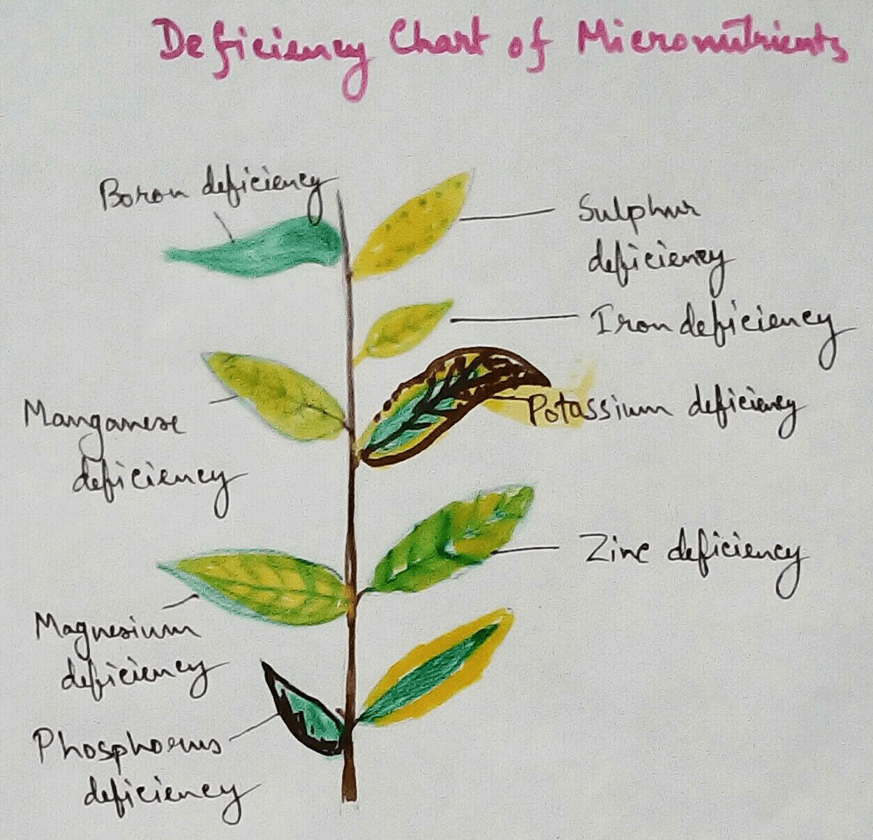Deficiency Symptoms of Essential Elements
Deficiency in plants can be caused due to following deficiency of the elements-
Nitrogen - As nitrogen is the major constituent of amino acids, proteins, hormones, enzymes, coenzymes, chlorophyll, vitamin, cytochromes etc thus chlorosis appear first in older leaves and growth stunted due to decrease protein synthesis, small size of cells are observed and slow divisions are observed which result in a premature leaf fall- that all occurs due to deficiency of Nitrogen.
Phosphorous - Synthesis of cell membrane and opening and closing of stomata, maintaining concentration, turgidity of cells are influenced by potassium. So deficiency of this element causes poor growthdulll green leaves followed by necrosis, poor vascular tissue, premature leaf fall.
Potassium - Potassium causes synthesis of proteins opening and closing of stomata and acts as activator of some enzyme thus, deficiency of this element causes marginal chlorosis ,necrosis ,loss of apical dominance, premature death etc.
Calcium - This is found in pectate, in middle lamella which is associated with the development of root stem epices, associated with cell membrane permeability and activator of some enzyme so deficiency of calcium causes degeneration of leaf margin specially root tips, leaves, found chlorosis curling appearance in young leaves and stunted growth with premature flower abscission.
Magnesium - Magnesium is the major constituent of chlorophyll and activator of enzymes of phosphate metabolism, fat synthesis carbohydrate metabolism and maintenance of ribosomes so deficiency of magnesium causes inter-veinal chlorosis, curling towards margins and the veins green.
Sulphur - This is major constituent of some amino acids ,proteins, vitamins, coenzyme and Ferredoxin. Deficiency of sulphur causes chlorosis leaf curling less juice content in citrus food ,nodulation in legumes reduced and defoliation in tea.
Iron - constituent of pyridoxine and cytochromes actors activator of catalyst and is essential for chlorophyll synthesis. Deficiency causes interveinal chlorosis with green veins appear first in young leaves with reduced growth.
Manganese - Associated with the photolysis of water ,it is also activator of carboxylase enzyme. Deficiency of this element causes interveinal chlorosis with grey spots or streaks, flowers sterile.
Molybdenum - Acts as activator of some enzymes which involved in nitrogen metabolism and nitrate reduction followed by nitrogen fixation. Deficiency of molybdenum causes mottled chlorosis with marginal infolding, necrosis ,whiptail in crucifers ,upper leaf half withering in monocots.
Boron - Boron is associated with calcium metabolism, Pollen germination cell differentiation, carbohydrate transport ,root nodulation. Deficiency of Boron causes Browning of cauliflower that is brown heart internal cok top sickness stunted growth, rosette of leaves, decreased nodulation in legumes.
Copper - Copper is a metal found in the pigment called plastocyanin, cytochrome oxidase, activator of certain enzymes. Deficiency of it causes leaf tip necrosis, blackening of potato tuber.
Zinc - Zinc is a metal used for the enzyme carbonic anhydrase auxin synthesis and is the activator of certain carboxylase. Deficiency of this element causes little leaf disease , shortening of internodes, interveinal chlorosis followed by necrosis.
Chlorine - It is associated with photolysis of water and maintaining balance of solute concentration and ions. Deficiency causes bronze coloured leaves, swallowing root tips ,flower obsession, wilting.
From Deficiency Symptoms of Essential Elements to HOME PAGE
Recent Articles
-
Explain about Growth in Plants |Definition of Growth & Differentiation
Feb 27, 25 02:07 PM
Growth is a permanent increase in length or volume of an organism that brought upon by an increase in its dimensions due to synthesis of new protoplasmic material. -
Definition of Respiratory Quotient | calculation | Application | Plant
Dec 02, 24 12:09 AM
Definition of respiration quotient- the ratio of the carbon-dioxide evolved to that of the oxygen consumed by a cell, tissue, plants or animals in a given time is called respiratory quotient. It is us… -
Amphibolic Pathway | Definition | Examples | Pentose Phosphate Pathway
Jun 06, 24 10:40 AM
Definition of amphibolic pathway- Amphibolic pathway is a biochemical pathway where anabolism and catabolism are both combined together. Examples of amphibolic pathway- there are different biochemical… -
Respiratory Balance Sheet | TCA Cycle | ATP Consumption Process
Feb 18, 24 01:56 PM
The major component that produced during the photosynthesis is Glucose which is further metabolised by the different metabolic pathways like glycolysis, Krebs cycle, TCA cycle and produces energy whic… -
Electron Transport System and Oxidative Phosphorylation | ETC |Diagram
Feb 04, 24 01:57 PM
It is also called ETC. Electron transfer means the process where one electron relocates from one atom to the other atom. Definition of electron transport chain - The biological process where a chains…








New! Comments
Have your say about what you just read! Leave me a comment in the box below.